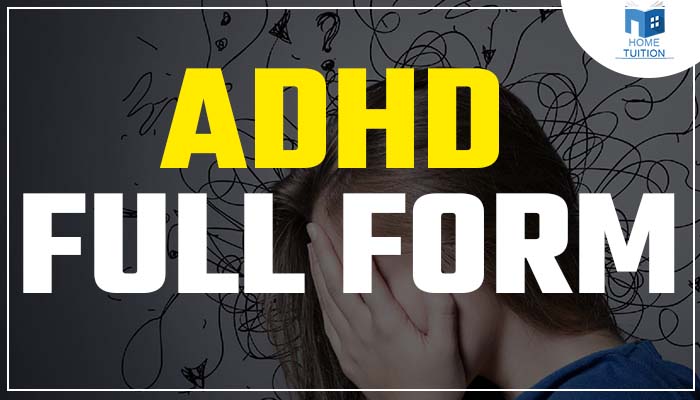Full form of ADHD
The full form of ADHD is “Attention Deficit Hyperactivity Disorder”. ADHD is one of the neurodevelopmental disorders that affect brain activity in such a way that a person cannot concentrate, has difficulty controlling sudden and spontaneous behavior, acts excessively, and is unable to sit in one place. It is a disorder that cannot be cured, although symptoms can be managed and improved with age with some therapy and counseling sessions. For a rapid diagnosis of this disorder, the symptoms must appear before the child reaches 13 years of age, or the symptoms must last 7 months or more and cause problems in at least two settings, such as school or home, or a group of people around.
What is ADHD?
Attention deficit/hyperactivity disorder (ADHD) is one of the most common mental disorders affecting children. Symptoms of ADHD include:
- Inattention (inability to sustain attention).
- Hyperactivity (an excessive movement that does not match the environment).
- Impulsivity (snap actions that occur at the moment without thinking).
ADHD is a chronic and debilitating disorder that affects individuals in many aspects of their lives, including academic and occupational achievement, daily functioning (Harpin, 2005), and interpersonal relationships. It can lead to poor self-esteem and social functioning in children if not treated appropriately (Harpin et al., 2016). Adults with ADHD may experience low self-esteem, sensitivity to criticism, and increased self-criticism, likely stemming from higher levels of criticism throughout life (Beaton et al., 2022). It should be noted that the presentation and assessment of ADHD in adults varies; this site is aimed at children.
An 2.5% of adults and an estimated 8.4% of children have ADHD (Simon et al., 2009; Danielson, 2018). It is first identified in school-aged children when it results in classroom disruptions or schoolwork problems. It is more diagnosed in boys than in girls due to differences in symptoms manifest. However, this does not mean boys are more likely to have ADHD. Boys tend to show hyperactivity and other externalizing symptoms, while girls tend to show inactivity.
Types of ADHD
According to the severity of the symptoms, ADHD is divided into three types:
- Combined Type: In this type, the patient will show almost all the symptoms of ADHD. The patient is hyperactive, impulsive, suffers from less concentration, and is easily distracted.
- Hyperactive Type: Patients who fall into this category are impulsive and hyperactive but do not distract or have concentration problems.
- Inattentive and Distracted Type: Here, patients suffer from inattention and are easily distracted but do not have any hyperactive or impulsive behavior.
Causes of ADHD
Scientists have not yet identified the specific causes of ADHD. While there is increasing evidence that genetics contribute to ADHD and several genes have been linked to the disorder, no specific gene or combination of genes has been identified as the cause. However, it is essential to realize that relatives of individuals with ADHD are also often affected. This is evidence of anatomical differences in the brains of children with ADHD compared to other children without the condition. For example, children with ADHD have reduced gray and white matter volume and show differential activation of brain regions during specific tasks (Pliszka, 2007). Other studies have shown that the frontal lobes, caudate nucleus, and cerebellar vermis of the brain are affected in ADHD (Tripp & Wickens, 2009). Several non-genetic factors have also been associated with this disorder, such as low birth weight, preterm birth, extreme stress, and exposure to toxins (alcohol, smoking, lead, etc.) during pregnancy.
Treatment of ADHD
Treatment for ADHD usually involves a combination of therapy and medication intervention. The recommended first-line approach for preschoolers and younger children include parent management training and school-based intervention behavioral strategies. Parent-Child Interaction Therapy (PCIT) is an evidence-based therapeutic modality that helps young children with ADHD and oppositional defiant disorder.
According to current recommendations, psychostimulants (amphetamines and methylphenidate) are the first-line pharmacological treatment for managing ADHD (Pliszka, 2007). In preschool ADHD patients, amphetamines are the only FDA-approved medication, although guidelines suggest that methylphenidate rather than amphetamines may be helpful if behavioral interventions prove insufficient. Alpha agonists (clonidine and guanfacine) and the selective norepinephrine reuptake inhibitor atomoxetine are other FDA-approved treatment options for ADHD. There are newer FDA-approved medications for ADHD, including Jornay (methylphenidate extended-release), which is taken at night and starts the medication effect the next morning, Xelstrym (dextroamphetamine), which is an amphetamine patch, Qelbree (viloxazin), which is medication. nonstimulant, Adhansia (methylphenidate hydrochloride), Dyanavel (amphetamine extended-release oral suspension), Mydayis (amphetamine mixed salt product), and Cotempla (methylphenidate extended-release orodispersible tablets).
Many children and families may alternate between different treatment options depending on the effectiveness of the treatment and tolerability of the medication. The goal of treatment is to improve symptoms and restore functioning at home and school.